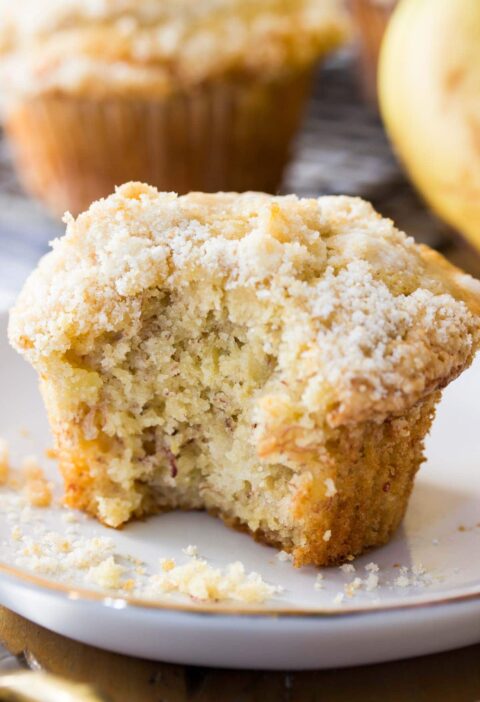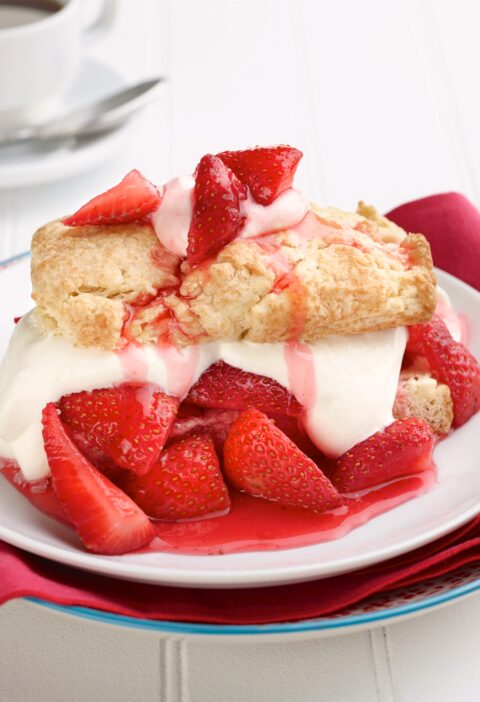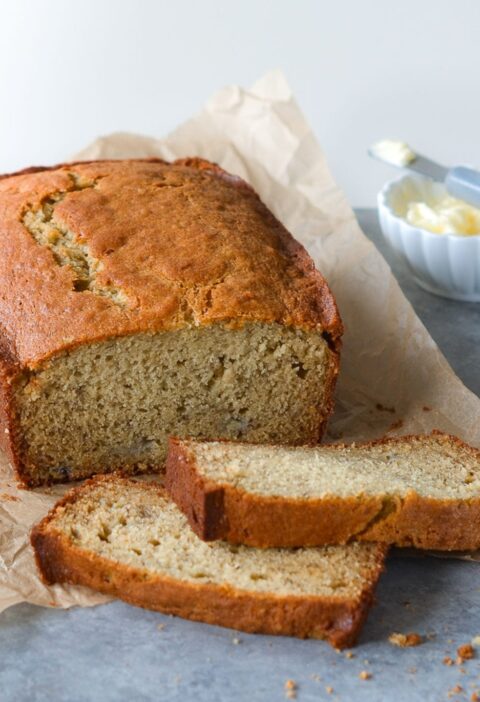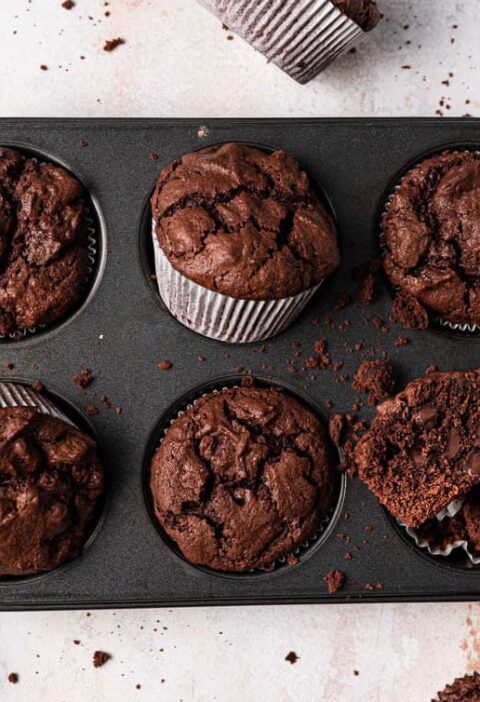Popovers may be fairly simple to make, but the science behind them is still complex, and each ingredient serves all the more an important purpose because of how few there are. The main point of difference compared to other pastries is the leavening agent, steam, which makes popovers hollow and leaves large air pockets in the texture. There is no need to add water directly to the batter, as butter, milk, and eggs already contain a large quantity of water. More specifically, milk is around 80 – 88% water, while egg yolk and egg whites are 50% and 88.0 % water respectively.
When the water in the batter evaporates during the baking process, the expansion of gas forces the batter to rise with the increased pressure. The pastry takes its unique shape because of the popover cups or muffin tins. The only direction the batter can expand in is upwards, due to the typically deep structure of popover cups, which means the top ends up puffy and crispy as convection heats the air around the top of the popover.
What keeps the popover from popping like a bubble is the protein in the flour and eggs. With the addition of the water in milk and butter, the glutenin and gliadin in the flour form the protein gluten. The heat denatures the structures of the protein, but does not break its peptide bonds, and the gluten coagulates into a sort of web as it forms around air bubbles but interacts with other proteins. Thus, the exterior is more exposed to heat than the interior, and sets first, trapping the gas inside it. To prevent the oven from cooking through to the inside of the popover and hardening it, after 15 minutes, the oven’s temperature has to be lowered so the popover structure holds. If you want a stronger gluten network for firmer popovers, you can also try half-bread flour, half-all purpose, since bread flour has a higher protein content.
Once the popovers are golden-brown, they can be taken out and served with jam or butter. This browning here would be the Maillard reaction, which happens because the amino acids in the proteins of the flour and the eggs react with the milk’s lactose, a reducing sugar. The brown found on a popover’s surface is partly made up of melanoidins, products of the Maillard reaction. The reason the reaction occurs within minutes despite being so complex is that the initial temperature of the oven is 425°F / 220°C; in order to get an acceptable Maillard result within minutes or hours, a temperature of more than 212°F (100°C) is needed. This initial heat produces the maximum amount of steam and kickstarts the reaction. This process is then completed by continuing to bake with the lower oven temperature.
Bibliography
- Bread Ingredients, Breads, Bread Basics, American Cooking Basics. Popover Ingredient Science. thespructEats, updated on 07/19/21. https://www.thespruceeats.com/popover-ingredient-science-481238. (Accessed 3/2/2023)
Summary: This article is by Linda Larsen, a journalist, and accomplished cookbook author with over 30 years of experience; she also has B.A. in biology from St. Olaf College and a B.S. with high distinction in food science and nutrition from the University of Minnesota. I believe it is unbiased. In no sections is it trying to advertise any products, only listing criteria for what a good popover or good popover pan should be like. It is split into sections based on each ingredient and piece of equipment involved in popovers in order to explain the science step-by-step. My biggest clue is that the science involved also matches up with what I learned in class about milk and eggs (as I chose this source before we reached that part). It also fills in gaps in my knowledge about what role popover cups play in the recipe. It also gives advice that makes sense, such as not using low-protein flour because protein is essential for the formation of the popover. I am confident in this source because the website has editors with good qualifications, accepts improvements by email, and the author of the article itself has good qualifications too. However, the lack of information on the editing and review process is disappointing.
- Cocktail Party Physics. Pop Goes the New Year: Popover Science. Scientific American, January 1, 2013. https://blogs.scientificamerican.com/cocktail-party-physics/pop-goes-the-new-year-popover-science/ (Accessed 4/9/2023)
Summary: This article is by Jennifer Oullette, admittedly not a scientist, but a science writer who had a job with the American Physical Society. However, the author cites several sources whenever she makes a claim, including thespruceeats (aforementioned source), so she clearly did her resource. A credible source is cited each time a claim is made about ingredients or definitions, so I believe those can be trusted. The author describes her own attempt and explains how she could have improved. Also, since popovers and Yorkshire puddings are so similar (mentioned in my more credible popover sources), the information provided on Yorkshire puddings (such as the fact that neither the batter nor eggs should be chilled so the ingredients don’t separate) ends up being more helpful than the rest of the article. I believe it is relatively unbiased, as most of the article is composed of explaining each role a popover’s ingredient plays and providing educational background information by comparing popovers to yorkshire puddings. The main problem is that the writing is overly ‘fluffy’. It’s not perfect and most of the comments are a bit irrelevant, but it serves to compile the most useful parts of other sources in one place. My confidence isn’t great. The scientific explanations promised in the title are lackluster, and the author does not have a background in science. However, it correlates with my textbook and notes from class, so I can use it for reference or comparison, at most.
- Cookware. Popover Pans: Are They Necessary for Perfect Popovers?. The kitchn, Feb 24, 2011. https://www.thekitchn.com/shopping-for-popover-pans-140010. (Accessed 4/9/2023)
Summary: Emma Christensen, a graduate of the Cambridge School for Culinary Arts and the author of True Brews and Brew Better Beer, wrote the article. The article is short, but it tries to advertise two kinds of popover racks to the viewer. It also advertises other articles on the site if the reader wants to learn more about popovers. Even though it includes advertisements, the article also spends more time focusing on the role popover racks play in the baking process than the products. Also, it recommends cast iron, which seems fitting for the purpose of popovers because I know from class that iron is slow to heat, but when heated, holds heat for a long time, which fits with how long it takes popovers to bake. It’s kind of threadbare and hasn’t been updated in a while, but there are still good bits of information. It explains why popover cups sometimes are welded to a wire rack, which I had been wondering about after looking up images online while doing my initial research. I do not feel great about this source, but I’m confident it has things I can use.
- Blog, Recipes. Baking with Olive Oil: Substitute for Butter & Vegetable Oils. Spanish Sabores, April 22, 2021. https://spanishsabores.com/baking-with-olive-oil/#How_to_Substitute_Olive_Oil_for_Butter. (Accessed 4/3/2023)
Summary: Lauren Aloise, who wrote the article, is a a trained chef – though it’s unclear where she trained – and she is co-founder of the company Devour Tours. She uses oliveoilsfromspain.org to her corroborate claims about olive oil health benefits, goes into a lot of detail about various kinds of oils. She also recommends many other recipes that use olive oil as a substitute, which I confirmed are indeed real recipes on my own. Additionally, every other source I checked also said the same thing about using olive oil – use ¾ of whatever amount of butter the recipe requires. I chose this source over all the others because it goes into more detail about the usage of olive oil and substitution, including the fact that you can’t substitute olive oil for butter in baking when a recipe calls for room temperature butter, so the solid butter will need to be mixed together with a type of sugar, which works because of specifically butter’s chemical make-up. Additionally, with nothing else to go on, I did try the ¾ advice when first baking olive oil popovers, and they turned out perfectly all right, so I have personal experience to back up the article for at least the help it provided for my recipe. I’m so-so confident about the rest of it, but I know the advice works.
- The Accidental Scientist, Science of Cooking. The Amazing Multi-Tasking Eggs. The Exploratorium, May 2003. https://annex.exploratorium.edu/cooking/icooks/article_5-03.html. (accessed 3/21/2023)
Summary: This section of the Exploratorium Museum website was written by Anne Gardiner and Sue Wilson, the authors of the book The Inquisitive Cook., and it talks about the various uses of eggs in recipes. Because it fits other things I’ve learned, I’m relatively confident in it. I’m mostly using this source because it specifically mentions steam formed from eggs as a leavening agent, building off what I already know. It happens to have everything relevant to my investigation, so even if it’s super informative, it’s still helpful to have. I have a half-hearted but certain confidence in this source. My main clue that it’s reliable is that it matches up with what I learned in class about eggs, and also what I’ve read in other sources I read for pre-class preparation about gluten and proteins. I would say it’s relatively unbiased. There’s a space where they advertise their newsletter, but it’s not too much. The article is just very short and not particularly descriptive.
- Herbst, Sharon Tyler; Herbst, Ron. The Deluxe Food Lover’s Companion, 2nd ed.; Barron’s Educational Series, 2015. URL: https://search.credoreference.com/content/title/barronflc?tab=contents
Summary: The author with the most qualifications is Sharon Tyler Herbst – a food and travel journalist, and past president and board member of the International Association of Culinary Professionals – and her husband and recurring co-author, Ron Herbst, a food and wine journalist and consultant. This work is a large reference volume that contains glossaries for various dishes and cooking processes, and the second edition contains more contemporary information. Entries are arranged alphabetically and cross-referenced. The intended audience is both experienced chefs and those who want to learn more about cooking. Many sources are listed in the bibliography, though there are no in-text citations. As it contains only definitions, there is little room for bias, but there aren’t enough details. From this book I acquired a definition of popovers that I used as a segue to discuss the science behind them and the adaptation I made in my Cookbook Project. The definition covers the basic ingredients used in popovers (eggs, milk, butter, and flour) and describes their puffy appearance, crediting this to the relatively high proportion of liquid in the batter that creates steam for the leavening agent. Most helpful was that it mentioned special popover pans are specifically meant to be “extra-deep”, which I was unable to tell just from looking at images of them online. This made it clear to me how vital the shape of the container is for popovers.
- Potter, Jeff. Cooking for Geeks: Real Science, Great Cooks, and Good Food. 2nd edition; O’Reilly Media, 2015.
Summary: Jeff Potter is the CTO of Enveritas, the previous VP of Engineering at the James Beard winning website Food52, and studied computer science and visual art at Brown University. He wrote the book as a resource for helping people improve as cooks and increase their knowledge of food through learning about chemistry. It covers culinary reactions with diagrams, as well as various recipes that demonstrate the scientific principles; interviews with researchers, food scientists, chefs, writers, and knife experts; and the different types of cooking styles. The range of topics is broad and the audience is anyone who would like to learn more about cooking. The author does not list sources, but as experts were interviewed and this is a book required for this class, I consider it reliable, since it covers so much and provides accessible explanations, but it can be difficult to navigate the chapters and there are points where does not elaborate enough; however, this last point is rectified by the other readings I have to do prior to class, as well as what I learn in class itself.
- This, Hervé; translated by Gladding, Jody. Kitchen mysteries: Revealing the Science of Cooking. Papaerback edition; Columbia University Press, 2010.
Summary: Hervé This is a French physical chemist who studied molecular gastronomy. He graduated from ESPCI Paris, and later obtained a Ph.D from the Pierre and Marie Curie University, having written and published many works on the subject of molecular gastronomy. He wrote this book with the intention of examining certain behaviors of food in the kitchen and helping non-scientists understand the why. It goes chapter by chapter with explanations, with the occasional diagram. The chapter I was interested in was the one on eggs, because it reinforced what I had already learned about eggs in class with additional details of the fact that with egg mixtures, the more there is of an additional liquid, the longer the cooking time. This is relevant due to the surprisingly long cooking time of the popovers, which I now know is caused by the high ratio of milk. In addition, the chapter on soufflé explained why it’s a bad idea to open the oven door to check on popovers why they back, as by that point the egg proteins will not have properly coagulated yet, and the opening of the oven door will cause the air and vapor bubbles within to contract; with the cooking already partially finished, the proteins surrounding the bubbles coagulated before they can reinflate, and cooking them for any longer would simply burn the popovers.




